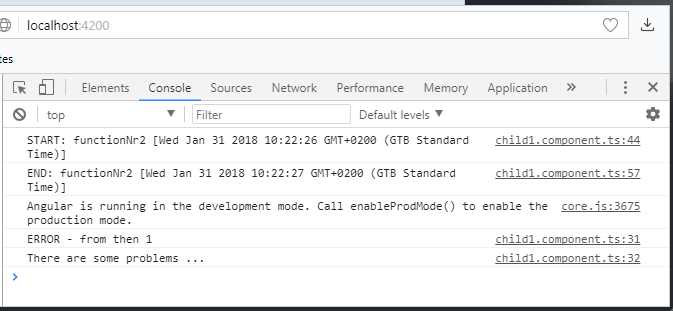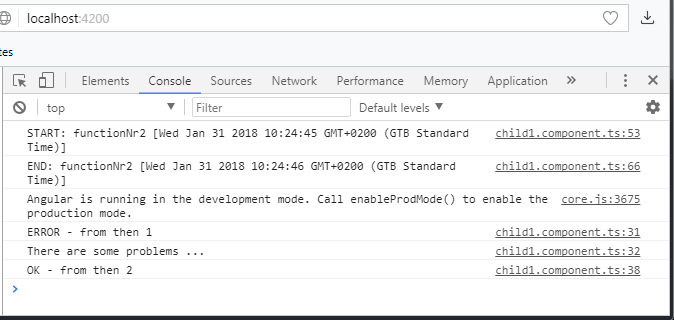#
What a Promise is in Angular ?
This tutorial explains to you what a promise is in Angular and also provide you with an example.
In Angular, sometime we need to use the following approach: run a ASYNC code, and function of an event (in that code) run the CODE-A or CODE-B (generally when an error occurs). This is an improvement of a Callback function in Angular. Using a Callback function, you will run something after a ASYNC call.
Take a look at the following example:
/* This is child1.component.ts file */
import { Component, OnInit } from '@angular/core';
@Component({
selector: 'app-child1',
templateUrl: './child1.component.html',
styleUrls: ['./child1.component.css']
})
export class Child1Component implements OnInit {
constructor() { }
ngOnInit() {
let promise = new Promise((resolve1, reject1) => {
// Do some ASYNC stuff
if (this.functionNr2() == 'OK') {
resolve1('OK');
} else {
reject1('There are some problems ...');
}
}).then(
(data1) => {
console.log('OK - from then 1');
console.log(data1);
},
(err1) => {
console.log('ERROR - from then 1');
console.log(err1);
}
);
}
functionNr2():string {
var num:number = 0
var count1:number = 0;
var count:number = 0;
console.log("START: functionNr2 ["+new Date()+"]");
for(num=0;num<=300000000;num++) {
if (num % 2 == 0) {
count1 = count1 + 2;
}
if (num % 3 == 0) {
count1 = count1 + 2;
}
if (num % 4 == 0) {
count1 = count1 - 2;
}
count++;
}
console.log("END: functionNr2 ["+new Date()+"]");
return 'nOK';
}
}And here is the output in the console when code completed:

Take a look at the following example:
/* This is child1.component.ts file */
import { Component, OnInit } from '@angular/core';
@Component({
selector: 'app-child1',
templateUrl: './child1.component.html',
styleUrls: ['./child1.component.css']
})
export class Child1Component implements OnInit {
constructor() { }
ngOnInit() {
let promise = new Promise((resolve1, reject1) => {
// Do some ASYNC stuff
if (this.functionNr2() == 'OK') {
resolve1('OK');
} else {
reject1('There are some problems ...');
}
}).then(
(data1) => {
console.log('OK - from then 1');
console.log(data1);
},
(err1) => {
console.log('ERROR - from then 1');
console.log(err1);
//throw new Error("fail");
}
)
.then(
(data1) => {
console.log('OK - from then 2');
},
(err1) => {
console.log('ERROR - from then 2');
}
);
}
functionNr2():string {
var num:number = 0
var count1:number = 0;
var count:number = 0;
console.log("START: functionNr2 ["+new Date()+"]");
for(num=0;num<=300000000;num++) {
if (num % 2 == 0) {
count1 = count1 + 2;
}
if (num % 3 == 0) {
count1 = count1 + 2;
}
if (num % 4 == 0) {
count1 = count1 - 2;
}
count++;
}
console.log("END: functionNr2 ["+new Date()+"]");
return 'nOK';
}
}And here is the output in the console when code completed:

Here are some remarks on the code above:
the functionNr2() simulate a ASYNC code;
you can use "then" keyword in order to execute some code after the promise return;
you can have maximum 2 procedures/ function you can run after a promise return a value (for completed without or with error cases);
you can have more than one "then" keyword used with a promise;
you can use throw new Error("fail") command, if you want to generate an error (for testing purpose);
At any time, a promise can be in one of these three states:
pending(when functionNr2() is running in my case)fulfilled(when functionNr2() returns "OK" in my case: a promise is considered fulfilled or resolved)rejected(when functionNr2() returns something that is not "OK" in my case: a promise is NOT considered fulfilled or resolved, so is rejected)
"then" keyword can be used to handle errors:
.then((data) => { console.log(data); })
.then(undefined, (error) => { console.log(error); });
you can use "catch" keyword much better to do the same thing:
.then((data) => { console.log(data); })
.catch((error) => { console.log(error); });
You can use
Promise.all([firstPromise, secondPromise, thirdPromise])feature in order the see if all promises are fulfilled. If one is rejected, Promise.all is rejected.You can use
Promise.race([firstPromise, secondPromise, thirdPromise])feature in order the see the result of the promise which will give you a response first.

